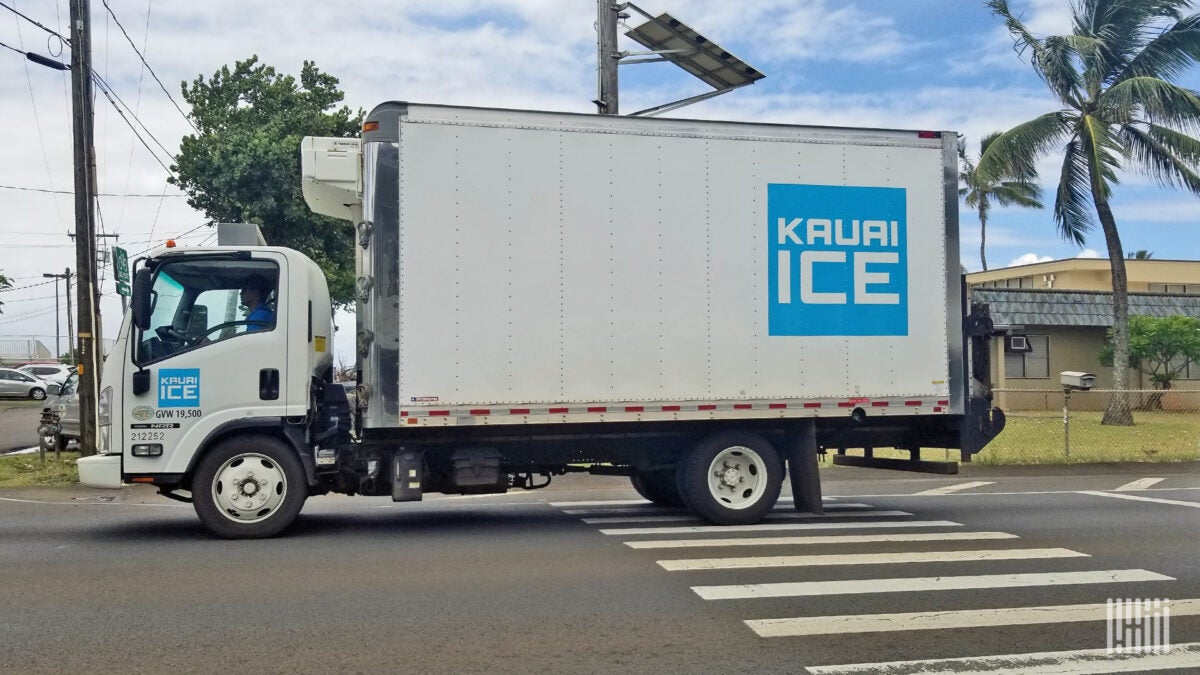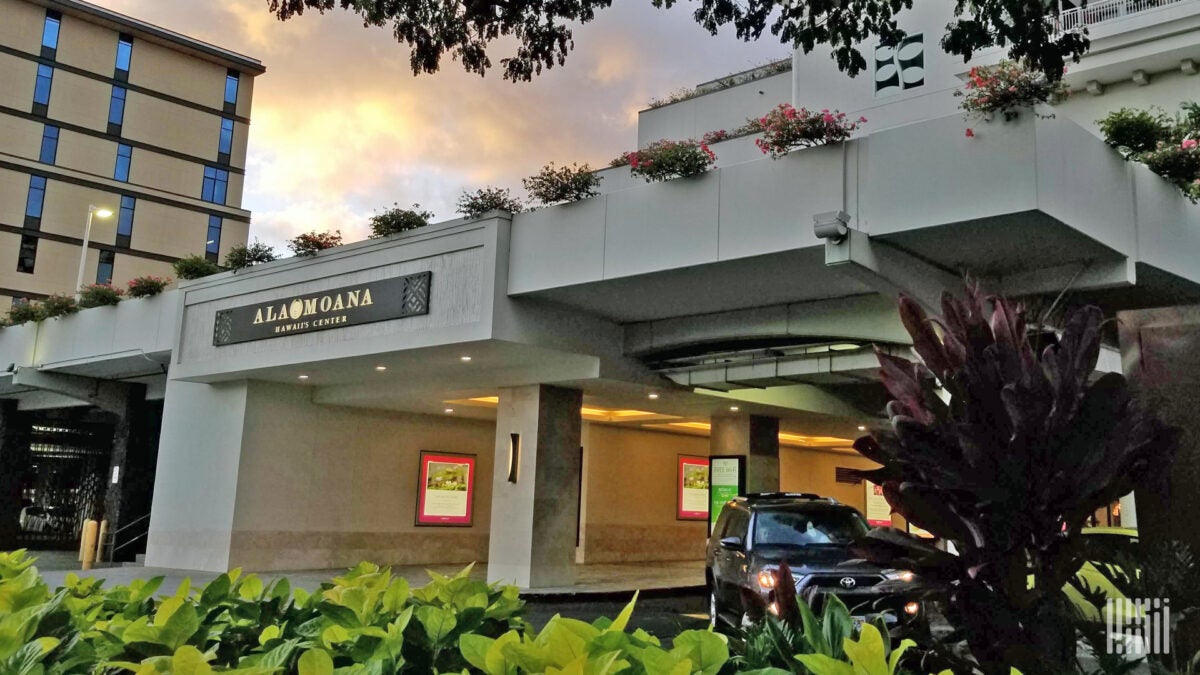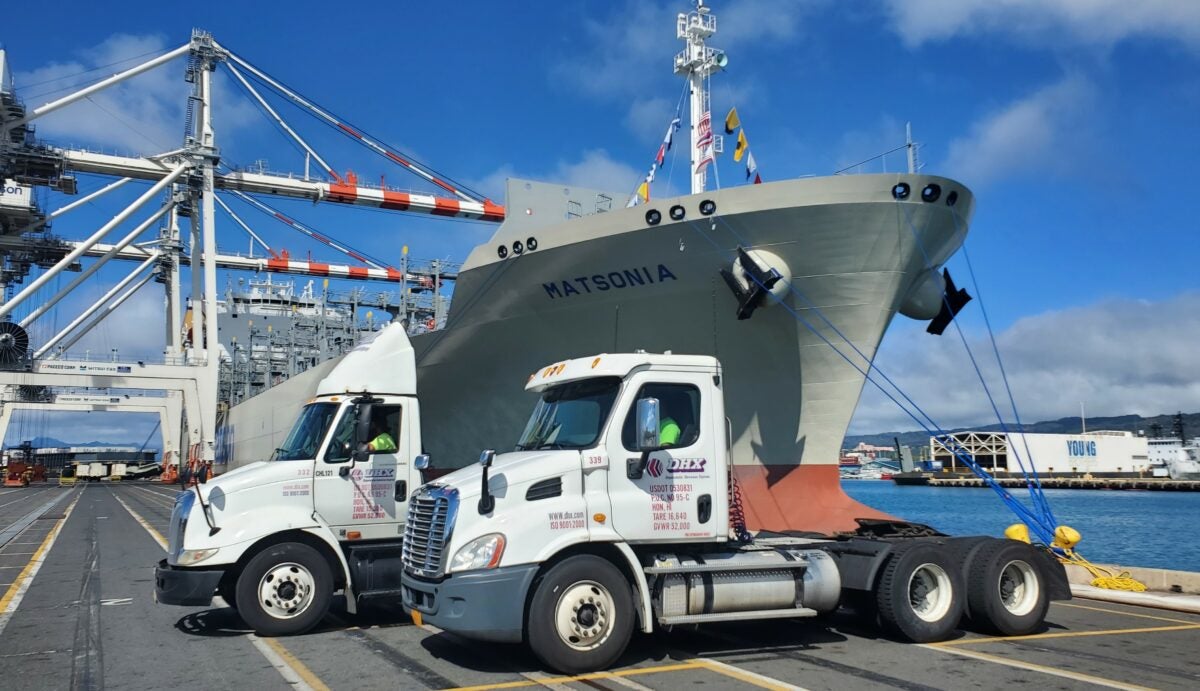Getting pineapple and gourmet seafood dinners on the plates of tourists near Waikiki Beach is not as simple as it may seem. Even if goods are locally sourced, truck drivers still need to transport the fresh food, park and deliver it to restaurants in high-traffic areas.
And in Hawaii, locating a loading dock is a tall order.
From a lack of loading docks and limited drivers to lava flows and narrow roads, the trucking industry in Hawaii must navigate many unique logistical challenges.
“Trucking in Hawaii is even more important than almost any other state,” Gareth Sakakida, COO at the Hawaii Transportation Association (HTA), told FreightWaves. “Other states have waterways, trains. We don’t have that within an island anyway.”
Indeed, each of the state’s islands relies heavily on its roadways and truckers. Increases in traffic and demand for goods due to tourism only exacerbate stresses on a system that’s not exactly packed with superhighways.
In other words, living and driving in paradise are two different things.
Interstates and highways in Hawaii
Hawaii has only a few interstates, all on the island of Oahu. Compared to the longest interstate in the U.S. — Interstate 90, which runs 3,020 miles from Seattle to Boston — Hawaii’s interstates are like blips on the map.
| Interstate | Distance | Location (all on the island of Oahu) |
| H-1 | 27 miles | Longest and most heavily trafficked interstate in Hawaii, spanning east to west. |
| H-2 | 8 miles | Runs north to south, connecting Wahiawa to Pearl City. |
| H-3 | 15 miles | Connects central Oahu (Aiea) to the east side of the island (Kaneohe/Kailua area). |
| H-201 | 4 miles | Auxiliary interstate to H-1, spanning a busy portion of the route between Aiea and Honolulu. |
Hawaii’s State Highway System comprises about 981.2 centerline miles of highways and roads and provides transportation mobility for more than 1.4 million Hawaii residents and 8 million visitors each year, according to the State of Hawaii Department of Transportation (HDOT).
Over 32 million tons of freight is hauled via this road network annually, the HDOT said. The busiest of these roads can see up to 20,000 trucks per day. Resource optimization, delivery schedules and contracts make travel time and dependability vital for trucking companies to stay competitive in the industry and retain customers.
However, HDOT data said that the Truck Travel Time Reliability (TTTR) Idex, a metric designed to “measure how consistent or dependable travel times are for freight vehicles,” received only a 2.54 out of 5 possible points.
Freight vehicles aren’t the only ones that have to plan around uncertain travel times. HDOT said that the percent of the “person-miles traveled on the interstate that are reliable” in terms of time traveled was 65.3% in 2019. That same figure for the state of New York was 78.8% in 2019, according to the Department of Transportation.
What causes delays and uncertain delivery times?
Hawaii’s limited network of major highways means driving even 5 miles at the wrong time of day in a passenger vehicle could take 30 minutes, Sakakida said.
But truck drivers don’t always have the option to avoid rush hour. Steady traffic and accidents on major highways regularly cause delays.
“If there’s any accident on the freeway … you’re in for it. There’s no movement for quite a while,” Sakakida said. “Everybody’s rerouting, so there’s no getting around it.”
“There’s not many ways to reroute your drivers around a major accident, especially when it’s on the one major highway that runs east to west across the island, so that really starts to delay things,” Kane McEwen, vice president of operations at trucking company Dependable Hawaiian Express (DHX) said of H-1, a major interstate on Oahu.
Straight trucks win out on narrow roads

“Over 95% of all goods being transported in Hawaii are manufactured and coming from somewhere else,” McEwen said. Most of that freight comes in via ocean vessels.
The extremely narrow, congested roads make it hard for trucking companies to navigate equipment any larger than a standard straight truck, McEwen said. Incoming ocean freight often must go to a warehouse to be split up for multiple straight trucks or smaller delivery vehicles because shipping containers are too difficult to maneuver on the roads.
This rehandling takes warehouse space, time and labor, which translates to higher costs. McEwen said a lot of these costs are passed along to the end consumer, and it’s part of the reason goods are so expensive in Hawaii.
The limit on truck sizes also means that drivers might have to go back for another load, or multiple trucks are needed to fulfill a larger delivery.
“I think it takes a higher level of skill to maneuver on our roads,” Sakakida said. But he said navigating the narrow roads is probably similar to driving in many other older cities that were not designed for large truck deliveries.
While some cities on the mainland have tight alleys and narrow streets, it “pretty much is nothing compared to the island of Oahu,” Joseph Vele, a Hawaiian truck driver and safety manager at DHX, told FreightWaves. Based on his 30 years of experience, he said the older residential areas are the most difficult to navigate, especially the Kaimuki area in Honolulu and the Kailua area on the east side of the island.
Nothing has changed in those areas for a long time, and drivers have to look out for low-hanging power lines and make tough decisions about what size of container or vehicle could realistically maneuver there, according to Vele. Delivering construction materials to those old residential areas is one of the most challenging parts of his job.
No loading dock, no problem …?

Hawaii’s largest mall and the largest open-air shopping center in the world, Ala Moana Center, “wasn’t built with deliveries in mind,” McEwen said. Ala Moana, similar to many crowded tourist areas in Hawaii, does not have proper loading docks.
Vele said he has delivered to Ala Moana many times over the years and described it as “a waiting game” because the tight turns and limited space often leave drivers waiting for a spot to park. He said drivers delivering to the shopping center frequently have to walk pretty far to transport their merchandise to customers.
“[In] the majority of other major cities, facilities are built with docks so you’re able to back up a container and they’re able to unload with a forklift or some type of machinery to unload the containers,” McEwen said.
That’s not the case in Honolulu.
He said there’s no room for automatic equipment, and truck drivers often have to “manually pallet jack freight out of the containers or out of the box trucks and have to use a liftgate.”
In Waikiki and other busy areas of Oahu where large volumes of freight deliveries are needed, many stores and hotels also don’t have loading docks.
“In Hawaii, the most important last-mile connectors are those needed for retail and hospitality deliveries in congested tourist corridors. Most establishments do not have dedicated loading zones on property, requiring trucks to park curbside to load and unload. Therefore, deliveries made during peak periods can exacerbate already congested roads and make it difficult for trucks to find convenient places to temporarily park,” the HDOT said.
Vele said he hasn’t heard of commercial vehicles getting hit by traffic, but safety is definitely something he thinks about when unloading on the side of the road. He said it’s fairly common for customers to help direct traffic around unloading trucks, especially on two-lane highways.
“Pre-COVID, it was pretty much packed. Vehicles would be parked all along on both sides of the street,” Vele said, noting that traffic is pretty much back to normal with tourists flocking to the island. “Sometimes you gotta park on the main road, and vehicles have to go around you. In order for you to make the delivery, that’s what you have to do.”
Finding qualified drivers
DHX requires truck drivers to have two years of over-the-road (OTR) experience, which is impossible to get in Hawaii, McEwen said. This creates a unique situation: People who want to drive in Hawaii for DHX often move to the U.S. mainland to get the OTR experience they need and then move back. McEwen said that many truck drivers from the mainland also move to Hawaii for a change of scenery.
Vele said some drivers moving to Hawaii expecting it to be very open “have no idea what they’re getting into.” The especially narrow lanes on H-1 and other roads leave little margin for error, which can make drivers new to the islands nervous, he said.
Because the islands are relatively small, one bonus to truck driving in Hawaii — besides the scenery — is that it’s easy for drivers to make it home every night instead of spending days or weeks on the road.
“You go to work, you drive a truck, and at the end of the day, you go home to your family. And that’s pretty much a 100% guarantee,” Vele said.
McEwen’s vision for DHX and Hawaii’s transition to sustainable transportation
Because Hawaii doesn’t have OTR driving and is “one of the sunniest places on earth,” McEwen said the state could operate on a fully electric trucking fleet if it were prioritized. EVs release zero tailpipe emissions, and the more that local energy grids invest in renewable energy such as wind and solar, the less greenhouse gases will be emitted as a result of charging EVs.
Vele said that Hawaii is “awfully green,” and if the state could move in the direction of electrifying its trucking industry, it probably would.
In 2017, the counties of Honolulu, Maui, Kauai and Hawaii committed to transforming Hawaii’s public and private ground transportation to 100% renewable fuel sources by 2045. Honolulu, Maui and Kauai counties each pledged to transition all fleet vehicles to 100% renewable power by 2035.
“With this announcement, we want to send a message that we welcome the next phase of Hawaii’s clean energy transformation, which will not only reduce our carbon dioxide emissions and fossil fuel imports, but will also ensure a more resilient future,” Kirk Caldwell, former mayor of Honolulu, said in a statement.
McEwen said if the state wants fleets to transition to zero-emission vehicles, the government will need to provide incentives. He said the price of goods would otherwise rise even more due to the higher initial costs of electrification.
Read: Will Maryland’s expanded EV charging network fuel fleet adoption?
What happens to this consumer state when disaster strikes?

Hawaii imports about 80% of the food it consumes, according to the HDOT. This makes the state extremely dependent on ocean and airfreight.
That puts Hawaii in a somewhat vulnerable position in case of a natural disaster or other emergency. Sakakida said that truckers are very helpful in the continental U.S. When there is a hurricane in Louisiana, for instance, truckers drive from across the country to help. But Hawaii has to rely on its own trucks to move goods regardless of the conditions because there is no easy way for the islands to get access to additional trucks and drivers.
“Help is not imminent,” Sakakida said. He added that the state could wait up to 14 days for medical supplies, food and water in the case of an emergency. Tsunamis, fires, hurricanes and other natural disasters are taken seriously by the transportation industry in Hawaii.
“A lot of people don’t understand that if no goods got transported, we’d be out of food in two weeks,” McEwen said.
Appreciation for truckers
While many people might take the trucking industry for granted, the COVID-19 pandemic has highlighted the importance of functional supply chains. And, Vele said, people in Hawaii notice when truckers maneuver large trailers expertly in tight quarters.
“When you’re backing up a container or trailer load and they’re watching and they’re witnessing it, in most cases, they’re pretty much amazed by how someone can actually do that,” Vele said.
Seeing customers’ eyes light up when they navigate difficult situations gives drivers a sense of appreciation and makes them feel good about what they do, he noted. That’s because …
“Driving here is always a challenge,” Vele said.
Consider it the price of living in paradise.
Click here for more FreightWaves articles by Alyssa Sporrer.
Related Stories:
Coast Guard delivers emergency supplies to typhoon-hit Pacific islands
Congress wants trucking to attract more women
Drilling Deep: A hurricane’s impact on trucking and how long it lasts








Bryce Mccloskey
Great story. Very informative.